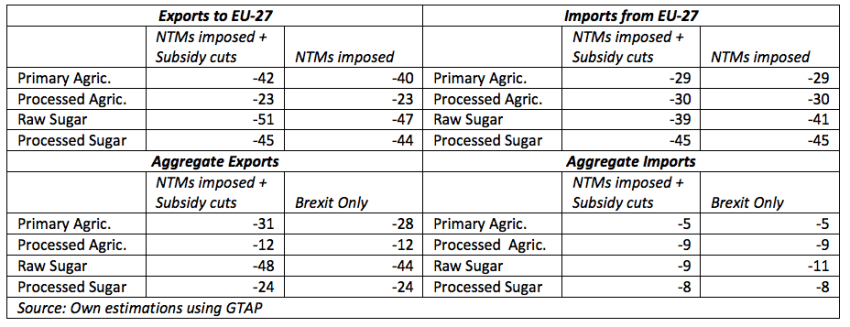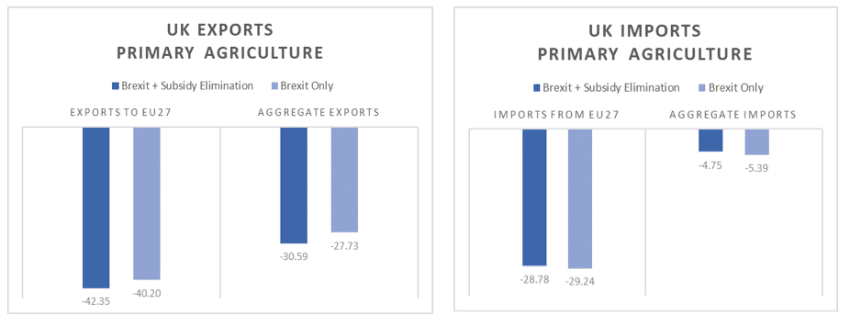Published
Brexit: The Marginal Effects of EU Agricultural Subsidies on UK Trade
By: Hanna Deringer Hosuk Lee-Makiyama
Subjects: European Union
Although it is yet unclear when exactly and under which conditions, but the UK will eventually leave the Single Market. Several studies have therefore assessed the expected impacts of reintroduced trade barriers on UK-EU trade in different possible scenarios.
However, Brexit is not only about trade barriers. It is also about agricultural subsidies, which UK producers will cease to receive under the Common Agricultural Policy (CAP). Unless the UK Government replaces those payments with national domestic support, UK farmers will lose a substantial source of funding. The UK’s environment secretary – and a contender for the country’s leading Brexiteer – has promised an end to “unjust” subsidies for rich landowners. The OECD Producer Support Estimate (PSE) for the EU-28, which reflects the annual support to agricultural producers, was 21% in 2016 as share of gross farm receipts, although the support to the UK farmers ought to be less than the EU average.
So how would a cut of these EU agricultural subsidies after Brexit impact UK trade in primary – i.e. the directly affected – and the processed – i.e. the indirectly affected – agricultural products? Would a cut of these agricultural subsidies eventually make a difference for agricultural trade in the UK?
The question is what matters more – regulatory divergence, or subsidies?
Using the standard static GTAP trade model (for specifications of the methodology see below) we simulated two scenarios in order to compare the impacts of Brexit on UK trade with and without the elimination of agricultural subsidies.
First, we looked at a scenario in which the EU-27 and UK would diverge on food safety standards after Brexit but agree to an advanced FTA with a typical, rather shallow chapter on Sanitary and Phytosanitary (SPS) measures. No tariffs or quotas are being introduced. Agricultural subsidies are not cut assuming that the UK Government would sustain the current level of subsidization received from the EU.
Second, in addition to introducing the described trade barriers under an FTA we eliminated EU subsidies on primary agricultural products in the UK to see if the expected impacts on UK agricultural trade would be different.
Subsidies Make Little Difference for UK Post-Brexit Trade
Overall, UK-EU trade in primary agricultural products is estimated to decrease substantially if the UK leaves the Single Market and becomes a third country, even though with preferential access under an FTA. Trade barriers for agricultural trade would mainly arise in the form of diverging product standards, especially in the dairy, meat and beverage sectors. In addition, there will also be horizontal requirements – e.g. certification, traceability, labelling and rules of origin requirements. An SPS chapter in an FTA could never entirely remove or avoid such requirements.
The impact of cutting off EU agricultural subsidies on UK trade is of another scale. The largest impact is expected for UK aggregate exports of primary agricultural exports since these become less competitive on global markets. UK exports in primary agricultural exports are estimated to decrease by about -31% while they would only decrease by -28% if EU subsidies were maintained.
Source: Own estimations using GTAP
Impacts on UK imports of primary agricultural products are estimated to be smaller than those on exports.
UK imports from the EU are also expected to fall substantially as a result of increased trade barriers. However, imports are estimated to reduce less than exports since it is more difficult for the UK to replace EU products in its domestic markets with own production or imports from other countries than it is for EU members, which can simply source from another one of the 27 member states.
Although to a much lower extent, aggregate UK imports of primary agricultural products are also expected to fall since the UK will produce at lower prices when domestic factor endowments are freeing up in the UK after loosing free access to its main export destination, the EU. In addition, third countries will replace some of the previous EU imports, assuming that the post-Brexit trade policy retains previous quotas or arrangements like GSP and EBA.
With an additional cut of farming subsidies, local producers become less competitive and therefore the UK will import relatively more primary agricultural products compared to a scenario with remaining subsidisation.
Less Impact on Processed Agricultural Goods
Looking at processed agricultural goods – which use primary agricultural goods as inputs – the estimations show no trade impacts for UK trade from the elimination of EU agricultural subsidies. For some sub-sectors such as e.g. processed sugar products (sgr) the results showed a slightly lesser reduction of bilateral exports (-44% instead of -45%) if subsidies were maintained, but overall for processed agricultural goods it made no difference for their trade whether subsidies were maintained or not.
UK Trade in Primary and Processed Agricultural Products
Source: Own estimations using GTAP
Conclusions
Our simulations assume a uniform average rate of NTMs across the food and beverage sector based on the available estimates (see below), although the relevance of product regulations vary between sectors. As a result, it can be concluded that the expected effects for UK agriculatural trade are severe above all in those cases where such NTMs would arise, with and without subsidy elimination. And a a post-Brexit trade agreement may provide for additional tariffs or TRQs.
The UK Government may be unable to sustain the domestic support received by the EU, but reinstated regulatory trade barriers towards the EU and lowered production cost in the UK seem sufficient to level the playing field between local unsubsidised production in the UK and EU production supported by CAP. Similarly, if the UK Government wanted to support UK agricultural trade, increasing national domestic support would not be an optimal strategy. It would be more important to focus on negotiating an ambitious trade agreement or specific SPS agreements with the EU – the UK’s biggest export market – that keeps new regulatory barriers limited and secures the least disruption of current trade flows.
Modelling Specifications
We used the latest GTAP 9 Database and the standard GTAP model, which is a static, multi-regional computable general equilibrium model.
To simulate post-Brexit trade under an FTA, new trade barriers were introduced as follows: Assuming an advanced trade agreement no tariffs have been introduced under the new FTA (e.g. under CETA almost all sectors will be traded duty-free quota-free after a certain phase-out period). For regulatory barriers, which are expected to re-emerge, parts of the non-tariff barriers estimated in an impact assessment of the FTA between the EU and Japan were introduced sector by sector. These estimates are considered to be the best available estimations of impacts that could arise from the reintroduction of non-tariff barriers on goods and services trade under a post-Brexit trade agreement. Since we do not expect that barriers would emerge to the same extent as between the EU and trade partners without an FTA (like Japan) only half of the actionable parts of the sector-specific regulatory barriers were introduced.
To simulate a cut of EU agricultural subsidies, EU domestic support was removed for the UK on primary (non-processed) agricultural products, while shares of national support payments remained. As primary agricultural products we considered GTAP sectors 01 to 12, as processed agricultural products sectors 13 to 26. Aggregated figures are trade weighted averages.
For simplicity, all third country relationships are assumed to remain unchanged. Furthermore, factors of production are not assumed as fully mobile between sectors, because we assume that a post-Brexit FTA and the resulting policy changes are being implemented and impacts are visible, but the economy would have not yet fully adapted as in the long-run.
